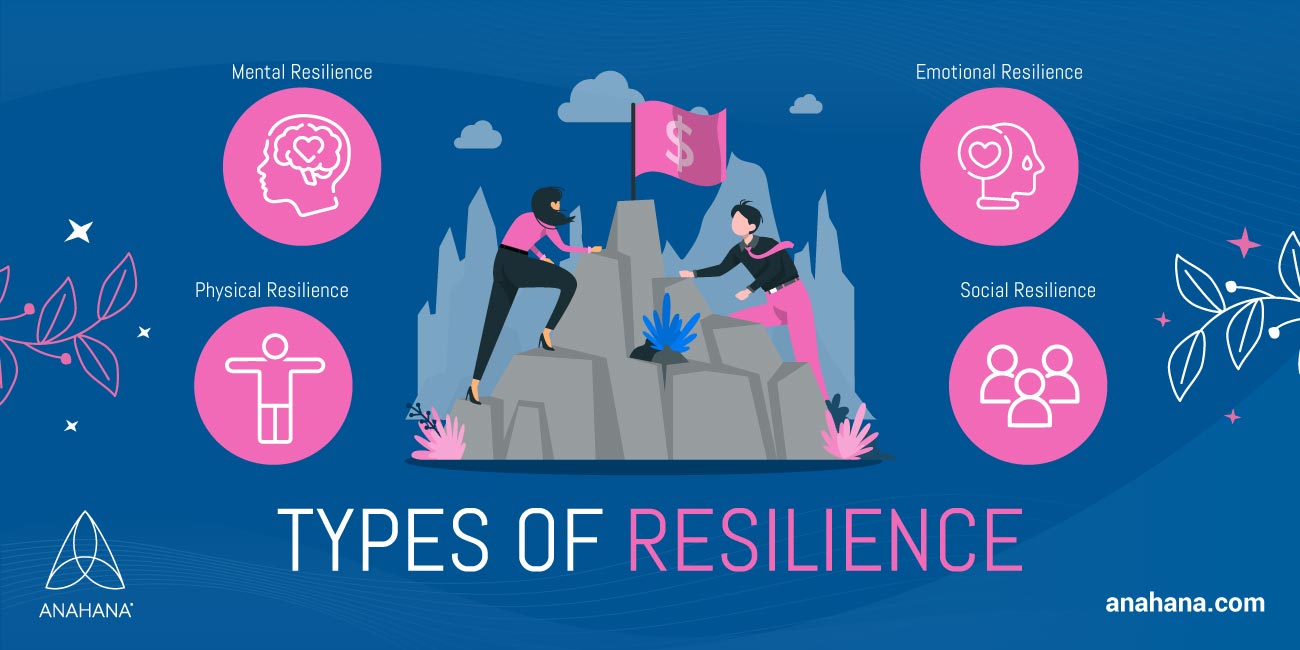
Table of Contents
Resilience, the ability to rebound from difficulties, is a life skill accessible to each of us. Through patience and perseverance, we can navigate hard times and emerge stronger.
What is Resilience?
The word resilience is derived from the Latin verb resilire, meaning to recoil or jump back. According to the American Psychological Association (APA), resilience refers to our remarkable ability to adapt or overcome adversity.
In our human journey, we often face tough times that can make resilience seem hard to connect with or believe in. But resilience isn't something fixed or that goes away; it's something that we each hold within ourselves, waiting to be tapped into.
In hard times, many of us turn to our beloved creature comforts and familiar, albeit imperfect or unhealthy coping strategies, seeking solace. These comforts are a natural part of being human, so rather than shaming ourselves, we can accept with ourselves with compassion and understanding.
At the same time, as we truly embrace and commit to our resilience, we will replace these coping behaviors with ones that nurture and support our well-being. After all, it's through the toughest moments that we often find our greatest strength.
Signs Of A Resilient Person
So, how does resilience show up in our everyday lives? Here are five signs to look out for:
Adaptability
Resilient people possess the remarkable ability to adapt to changing circumstances with grace and flexibility. Consider the story of a friend who faced unexpected setbacks but remained open to new possibilities, adjusting their plans and finding innovative solutions along the way.
Positive Outlook
“When there’s a big disappointment, we don’t know if that’s the end of the story. It may be just the beginning of a great adventure,”― Pema Chödrön, When Things Fall Apart: Heart Advice for Difficult Times.
Maintaining a hopeful outlook can illuminate even the darkest moments, fostering resilience in the face of adversity. Think of someone who, despite encountering obstacles, chooses to see setbacks as opportunities for growth and transformation, finding strength in optimism.
Strong Support System
Resilience flourishes in the nurturing embrace of supportive relationships. Picture a community of loved ones who offer unwavering encouragement, empathy, and assistance, providing a lifeline of support during challenging moments.
Emotional Awareness and Regulation
Digging deep and accessing our resilience means, having a deep understanding of our emotions and accessing healthy coping mechanisms to work through them. Engaging in practices like mindfulness or self-reflection, which help us process and understand our emotions, can be incredibly grounding and stabilizing.
Sense of Purpose
A sense of purpose grounds us and fuels our resilience, giving meaning and direction to our journey. Consider people we know or look up to (maybe both!) who find purpose in their passions and values, driving them to take meaningful action and persevere through challenges with determination and resolve.
By noticing and nurturing these signs of resilience in ourselves and those around us, we can get through the hard times, and really witness how strong and capable we are.
Types of Resilience

Resilience encompasses numerous strengths that support us through difficult times. Let's explore the four main types: psychological, emotional, physical, and community resilience.
Psychological Resilience
Psychological or mental resilience is all about our inner strength, how we handle tough situations without getting overwhelmed (or at least, so overwhelmed that we avoid or can't see potential solutions or paths forward). For example, think of someone who faces a setback at work but stays focused and optimistic, finding ways to move forward.
Emotional Resilience
Emotional resilience is all about how we manage and regulate our feelings, especially when times get tough. It's like knowing when we're feeling stressed or upset and finding healthy ways to cope, whether it's talking to a friend or doing something we enjoy.
Physical Resilience
Our bodies are the vessels through which we experience life, and physical resilience is what keeps them strong and vibrant. It's about bouncing back from illness or injury, staying active, and nurturing our bodies with rest, nourishment, and joyful movement.
Community Resilience
Community resilience is simply the shared strength that emerges when groups face tough situations together. It's about how communities come together, support one another, and find solutions during challenging times, whether it's recovering from a natural disaster or navigating economic hardships. It's the power of connection and solidarity in action
Nurturing Resilience: 3 Practical Benefits for Everyday Life
Resilience, often overlooked, is our secret superpower for overcoming personal challenges. Here are three reasons why nurturing resilience is not only beneficial but also crucial for our everyday well-being:
-
Stress Relief: Resilience helps us navigate tough situations with a clear head. Think about a time when you stayed composed during a challenging moment, relying on your inner strength to stay steady.
-
Self-Compassion: Resilience empowers us to practice self-compassion, offering kindness and understanding to ourselves when we stumble or fall. Picture a caring friend offering words of encouragement and support, reminding you that it's okay (and normal!) to be imperfect.
-
Confidence Boost: Resilience fuels our self-belief, empowering us to face challenges head-on. Recall a situation where you got through something incredibly difficult and emerged stronger; this showcases your resilience while increasing your self-efficacy and confidence.
How to Build and Maintain Resilience
While age, personal history, and environment contribute to our initial resilience levels, it's important to remember that our resilience is fluid, not set in stone. Beautifully, children develop resilience over time, offering insights into its cultivation for adults.
Acknowledge, Hold Space For, and Reframe Negative Thoughts
We can become more resilient by engaging in mindful thinking and reflection. As part of cognitive behavioral therapy, building resilience means mindfully reflecting on and altering negative behaviors and thought processes. The first step is to engage in positive self-talk and identify positive and negative emotions and behavior patterns.
Resilience research also suggests that an inability to effectively deal with difficulties (through not utilizing our resilience skills) can lead to negative emotional states or mental health conditions such as depression, anxiety, and stress.
Calm Your Mind and Body
The second step is to harness our inner strength and adapt coping skills that tend to our needs, helping us lower stress levels.
There are ways to breathe that directly impact our biological states that will calm us. Common coping mechanisms include exercise, physical activity, deep breathing, improving sleep hygiene, getting enough sleep, and doing activities or hobbies we enjoy.
Counterintuitively, Try to See The Bright Side
Finding the light in the darkness may seem like a tall order, especially when life throws its toughest challenges our way. Yet, even amidst the stormiest of circumstances, glimmers of hope await our discovery.
In moments of adversity, practicing positive self-talk might initially feel foreign or even frivolous. However, research suggests that flooding our minds with optimistic thoughts can quell the noise of negativity, sharpening our focus in the process. By reframing our perspectives through a more positive lens, we not only shift our emotional landscape but also pave the way for transformative actions.
Fostering resilience takes time and practice, it isn't a sign that we lack resilience. Sometimes, it can be even challenging to understand where to start and what coping skills to utilize, especially when we aren't feeling our best. In these cases, reaching out to a mental health professional who can guide us through the process can be the ultimate form of self-care.
Conclusion
Every one of us can build skills to develop resilience. During hard moments, we can mindfully focus on the present (rather than ruminate or worry about the past or future "what ifs"). Over time, and patiently, we can harness positive emotions and strength to build resilience and grow.
References
Resilience: What it is and is not | Walker, B. H. (2020)
How to be more resilient: 8 ways to build your resilience | Calm
Managing stress and building resilience | mind.org
Disclaimer
The contents of this article are provided for informational purposes only and are not intended to substitute for professional medical advice, diagnosis, or treatment. It is always recommended to consult with a qualified healthcare provider before making any health-related changes or if you have any questions or concerns about your health. Anahana is not liable for any errors, omissions, or consequences that may occur from using the information provided.

By: Anahana
The Anahana team of researchers, writers, topic experts, and computer scientists come together worldwide to create educational and practical wellbeing articles, courses, and technology. Experienced professionals in mental and physical health, meditation, yoga, pilates, and many other fields collaborate to make complex topics easy to understand.
